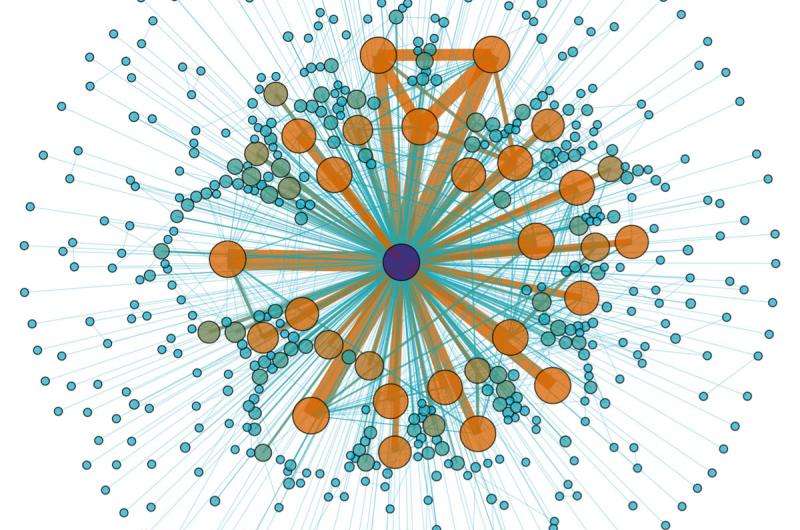Collaboration network of Hungarian mathematician Paul Erdos, with Erdos as the central node, collaborators as peripheral nodes, and node link thickness proportional to the number of coauthored publications. Orange nodes denote Erdos’ super ties, with whom he coauthored more than 15 publications. Credit: Alexander M. Petersen
(Phys.org)—Alexander Michael Petersen, a researcher with the Lucca Institute for Advanced Studies in Italy has conducted a study looking into one measure of scientific career success—publication—and found that those people that pair with another researcher to form a long term collaboration, tend to have more productive careers. In his paper published in Proceedings of the National Academy of Sciences, Petersen describes the study he carried out, and what he found along the way.
Most people probably realize that collaborations generally result in better work, both in and out of the sciences, due to the beneficial results of more minds working simultaneously on one or more problems, but do things work out better when two people work on multiple projects over many years, versus individuals building a career with serial pairings with different partners? That is what Petersen sought to learn.
To find out, he studied publications by 473 physicists and biologists over the course of their careers, which covered 94,000 papers and involved 166,000 collaborators. In so doing, he discovered that between 60 and 80 percent of any given researchers' collaborations lasted just one year or even less. He also identified what he terms super-ties, where pairs of collaborators worked together for decades—sometimes working together on roughly half of their projects. When comparing researchers that were part of super-ties against those that engaged in serial pairings, he found long-term pairings increased publication numbers for an individual researcher by, on average, 17 percent. Thus he concludes that long-term pairings on collaborative efforts are likely to increase a researcher's publication productivity and in so doing boost his or her career development and success.
Petersen's paper also highlights what some consider a problem in scientific publications—people doing just enough work on an effort to get their name on a paper, bolstering their resumes by appearing as a researcher/author on multiple papers and thus engaging in multiple collaborations—in effect, gaming the system. Also, Petersen's efforts focused on collaborative pairs—what is still not clear is whether researchers who are part of larger groups who collaborate together for many years gain the same sort of productivity boost.
More information: Quantifying the impact of weak, strong, and super ties in scientific careers, Alexander Michael Petersen, PNAS, DOI: 10.1073/pnas.1501444112
Abstract
Scientists are frequently faced with the important decision to start or terminate a creative partnership. This process can be influenced by strategic motivations, as early career researchers are pursuers, whereas senior researchers are typically attractors, of new collaborative opportunities. Focusing on the longitudinal aspects of scientific collaboration, we analyzed 473 collaboration profiles using an egocentric perspective that accounts for researcher-specific characteristics and provides insight into a range of topics, from career achievement and sustainability to team dynamics and efficiency. From more than 166,000 collaboration records, we quantify the frequency distributions of collaboration duration and tie strength, showing that collaboration networks are dominated by weak ties characterized by high turnover rates. We use analytic extreme value thresholds to identify a new class of indispensable super ties, the strongest of which commonly exhibit >50% publication overlap with the central scientist. The prevalence of super ties suggests that they arise from career strategies based upon cost, risk, and reward sharing and complementary skill matching. We then use a combination of descriptive and panel regression methods to compare the subset of publications coauthored with a super tie to the subset without one, controlling for pertinent features such as career age, prestige, team size, and prior group experience. We find that super ties contribute to above-average productivity and a 17% citation increase per publication, thus identifying these partnerships—the analog of life partners—as a major factor in science career development.
Journal information: Proceedings of the National Academy of Sciences
© 2015 Phys.org






















